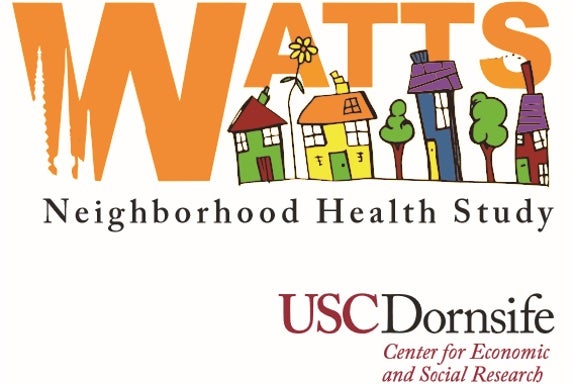Watts Neighborhood Health Study
Overview

 The Watts Neighborhood Health Study (WNHS) is a longitudinal research study looking at the effects of neighborhood built and social environments on obesity for low-income, urban populations. To study the causality of these effects, the WNHS collects data from residents at the Jordan Downs (JD) public housing project as well as two control public housing sites in the Watts neighborhood of Los Angeles. This study is generously funded by grants from the National Cancer Institute, as well as the Eunice Kennedy Shriver National Center for Child Health and Human Development.
The Watts Neighborhood Health Study (WNHS) is a longitudinal research study looking at the effects of neighborhood built and social environments on obesity for low-income, urban populations. To study the causality of these effects, the WNHS collects data from residents at the Jordan Downs (JD) public housing project as well as two control public housing sites in the Watts neighborhood of Los Angeles. This study is generously funded by grants from the National Cancer Institute, as well as the Eunice Kennedy Shriver National Center for Child Health and Human Development.
About the Jordan Downs Redevelopment
Unlike other studies looking at the relationship between neighborhood and obesity, the WNHS uses a natural experiment design to examine how changes to the environment impact obesogenic behaviors and outcomes. As part of a five-year, 1 billion dollar project funded by the city of Los Angeles, the JD public housing project will be redeveloped to include the following:
- 700 new units for existing residents
- 700 new units for new, mixed-income housing residents
- A new community center with a gymnasium
- A retail space that will offer healthy eating opportunities
- Green space that will increase opportunities for physical activity
- Additional built environment enhancements that will promote physical activity and healthy eating (i.e. walking and bike lanes, street lighting).
By studying the behaviors and health outcomes of residents prior to this redevelopment, as well as following each cohort of residents after they have experienced the redevelopment changes, the WNHS can explore how direct, neighborhood environments, impact obesogenic outcomes.
To learn more about the JD redevelopment project, please visit the following sites:
LA Business Journal: $1 Billion Overhaul Underway For Jordan Downs Complex in Watts
Housing Authority of the City of Los Angeles: Jordan Downs Relocation Plan
The Survey

Annual Survey Topics
The Watts Neighborhood Health Study (WNHS) collects survey data from an ongoing cohort of over 1,600 adults and children living in three public housing sites: Jordan Downs, Imperial Courts, and Nickerson Gardens. This data is collected through in-person, interviewer-administered surveys. During the Covid-19 pandemic, interviews were switched to be 100% remote (conducted over the phone).
To capture the relationship between environment and obesity, respondents are surveyed about the following topic areas:
-
 This includes general questions about neighborhood safety, infrastructure, and social connectivity. In later waves of data collection, this section also asked about the Jordan Downs redevelopment and its possible impacts on the community.
This includes general questions about neighborhood safety, infrastructure, and social connectivity. In later waves of data collection, this section also asked about the Jordan Downs redevelopment and its possible impacts on the community. -
 Respondents are asked about their exercise habits, involvement in physical activities, eating habits, food shopping habits, and barriers to both eating healthy and exercising.
Respondents are asked about their exercise habits, involvement in physical activities, eating habits, food shopping habits, and barriers to both eating healthy and exercising. -
 Respondents are asked about their sedentary habits such as how often they watch television, play video games, browse the internet, etc.
Respondents are asked about their sedentary habits such as how often they watch television, play video games, browse the internet, etc. -
 Respondents are asked about various aspects of their mental health such as stress, coping ability, loneliness, and depressive feelings.
Respondents are asked about various aspects of their mental health such as stress, coping ability, loneliness, and depressive feelings. -
 In addition to specific questions about diet/exercise lifestyle behaviors, respondents were also asked about other aspects of their well-being and physical health, such as their sleep schedules, any health condition diagnoses, and their overall opinions about their own health.
In addition to specific questions about diet/exercise lifestyle behaviors, respondents were also asked about other aspects of their well-being and physical health, such as their sleep schedules, any health condition diagnoses, and their overall opinions about their own health. -
 This includes questions about each respondents social network and the perceptions that they have of those in their network. Examples of questions in this section include how many people in their network are overweight/obese, how often people exercise, how healthy people eat, etc.
This includes questions about each respondents social network and the perceptions that they have of those in their network. Examples of questions in this section include how many people in their network are overweight/obese, how often people exercise, how healthy people eat, etc.
Publications and Briefs
-
Datar, A., Shier, V., Braboy, A., Jimenez, M., Hernandez, A., Ellen King, S., & Liu, Y. “Assessing impacts of redeveloping public housing communities on obesity in low-income minority residents: Rationale, study design, and baseline data from the Watts Neighborhood Health Study.“ Contemporary Clinical Trials Communications 25 (2022): 100879.
- Summary: This paper describes the purpose and study design for the Watts Neighborhood Health Study. This study leverages a natural experiment created by the redevelopment of a public housing community to examine the impact of major improvements to the housing, built, and social environments on obesity among residents. Residents from the redeveloped community(treatment group) will be compared to those from a similar community (control group) in terms of their pre/post changes in primary outcomes using annual longitudinal data on a cohort of residents. This study offers a unique opportunity to assess whether improvements to housing, built, and social environment in low-income minority communities can lead to reductions in obesity.
Liu, Y., Shier, V., King, S., & Datar, A. “Predictive Utility of Alternate Measures of Physical Activity and Diet for Overweight and Obesity in Low-Income Minority Women.” American Journal of Health Promotion 36.5 (2022): 801-812.
- Summary: In this paper, we compare the performance of alternate measures of diet and physical activity for predicting over-weight and obesity in a sample of low-income minority women. The goal is to assess whether measures based on approaches that are more time and resources-intensive add value over easy-to administer single-item measures in terms of their predictive utility for overweight and obesity. The models are built up starting with least resource-intensive measures of diet and physical activity (single items) and sequentially adding more resource intensive measures. The results indicate that single-item questions for diet and physical activity can provide valuable information about risk for overweight and obesity in this population.
Shier, V., Miller, S., & Datar, A. “Heterogeneity in grocery shopping patterns among low-income minority women in public housing.” BMC public health 22.1 (2022): 1-11.
- Summary: The purpose of this study was to examine the variability in grocery shopping patterns, and the factors that predict them, among low-income minority women in public housing. Interviewer-administered surveys and body composition measurements were collected from an ongoing longitudinal cohort study of low-income urban public housing residents located in South Los Angeles. Grocery shopping patterns were associated with several participant characteristics, including race/ethnicity, working status, access to a car, income, and education. Hispanic participants were less likely to shop at a supermarket, travel further distances to shop, shop more frequently, and were more likely to prioritize price in their choice of primary grocery store than non-Hispanic Black women participants. Results indicate that, even within low-income, minority communities, there is considerable variation in households’ grocery shopping patterns, including the types of grocery stores accessed, distance travelled, frequency of shopping, and reasons behind grocery store choice, and that these patterns were associated with individual and household characteristics.
Datar, A., Shier, A., & Liu, Y. “Understanding drivers of micro-level disparities in childhood body mass index, overweight, and obesity within low-income, minority communities.” Preventive Medicine Reports 32 (2023): 102143.
- Summary: This study examines childhood obesity disparities on a micro-level within minority and low-income populations. We analyze data on 497 parent–child dyads living in public housing communities in Watts, Los Angeles. Cross-sectional multivariable linear and logistic regression models were estimated to examine whether individual and family level factors predict children’s BMI z-scores, overweight, and obesity in the sample overall and separately by child’s gender and age group. Parental BMI was the strongest and most consistent predictor of child zBMI, overweight, and obesity, even after controlling for parent’s diet and activity behaviors and home environment. The parenting practice of limiting children’s screen time was also protective of unhealthy BMI in younger children and females. Overall, our findings show that there is considerable heterogeneity in child BMI, overweight, and obesity even within low-income communities with similar socioeconomic and built environments in their neighborhoods.
Wong, E., Liu, Y., Shier, A., & Datar, A. “Heterogeneity in COVID-19 vaccine uptake within low-income minority communities: evidence from the Watts Neighborhood Health Study” BMC Public Health (2024) 24:503
- Summary: This study examines COVID-19 vaccine uptake disparities within low-income, minority communities with similar socioeconomic backgrounds in South Los Angeles, CA. Specifically, it focuses on Black-Hispanic disparities and disparities within the Hispanic community by country of origin. Data from the Watts Neighborhood Health Study’s fourth wave (June 2021- May 2022) is analyzed. Mexican Hispanic and non-Mexican Hispanic participants were significantly more likely to be vaccinated compared to non-Hispanic Black participants. Attitudes towards COVID-19 vaccines played a role in reducing the disparity between Black and Hispanic participants. Differences in vaccination rates within the Hispanic community by country of origin were observed but became insignificant after controlling for individual and household characteristics. The study highlights the importance of addressing racial and ethnic disparities in COVID-19 vaccination within marginalized communities to ensure vaccine equity in public health efforts.
Miller, S., Shier, V., Wong, E., & Datar, A. “A natural experiment: The opening of a supermarket in a public housing community and impacts on children’s dietary patterns.” Prev Med Rep. 2024 Mar; 39: 102664.
- Summary: The study aimed to investigate changes in dietary patterns among low-income, racial and ethnic minority children living in a public housing community after the opening of a new supermarket. Data from the Watts Neighborhood Health Study in South Los Angeles was used, with surveys conducted on children aged 9-17 years and adults in the household. The study found that living near the new supermarket did not significantly impact dietary outcomes overall. However, children in households without vehicle access showed increased fruit and vegetable consumption when living close to the supermarket. The results suggest that neighborhood food environments may not improve dietary outcomes unless individuals face transportation barriers, highlighting the need for comprehensive interventions.
-
COVID-Related Hardships in Low-Income Minority Families: Children’s Education was a Bigger Hardship Than Income and Food Security; McConnell, L., Shier, V., King, S., & Datar, A., (2021). Research Brief, University of Southern California Center for the Changing Family.
-
Stakeholders’ Perspectives on the Jordan Downs Public Housing Redevelopment in Watts. Perrigo, J., PhD, LCSW1, Scott, J., MPA, BA2, Kim, K., BS3, Shier, V., PhD4, & Datar, A., PhD4. Affiliations: 1Luskin School of Public Affairs, University of California, Los Angeles, USA; 2Sol Price School of Public Policy, University of Southern California, USA; 3Keck School of Medicine, University of Southern California, USA; 4Center for Economic and Social Research, University of Southern California, USA
Team
Ashlesha Datar, PhD

Victoria Shier, PhD
Marai Jimenez-Ortiz
Project Specialist

Angelica Hernandez
Project Specialist

Ying Liu
Research Scientist

Bart Orriens
Managing IT Director

Swaroop Samek
Computer Systems Engineer, Senior
Jose Scott

Contact Us
If you have any specific questions or you would like to learn more about the Watts Neighborhood Health Study, please contact us using the information provided below:
Email: jimenezo@usc.edu OR ah_934@usc.edu | Phone: 213-821-8810
 For questions related to the Jordan Downs Redevelopment project, please contact the Housing Authority of the City of Los Angeles, or visit their website:
For questions related to the Jordan Downs Redevelopment project, please contact the Housing Authority of the City of Los Angeles, or visit their website:
Phone: (213) 252-2500 | TDD: (213) 252-5313
Website: www.hacla.org